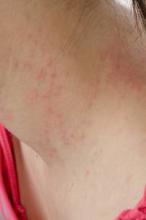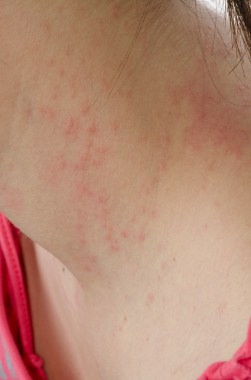User login
Contrary to conventional wisdom, atopic dermatitis persists well into the second decade of life and probably longer, based on data from a prospective longitudinal study published online April 3 in JAMA Dermatology.
At every age studied (2-26 years), more than 80% of patients reported having symptoms of atopic dermatitis (AD) or taking AD medication in the past 6 months, reported Dr. David J. Margolis and his associates at the University of Pennsylvania, Philadelphia.
"Past teaching that nearly 50%-70% of children with AD will achieve a resolution of their AD by age 12 years was not achieved in our study," the researchers said (JAMA Dermatol. 2014 April 3 [doi:10.1001/ jamadermatol.2013.10271]).
The study enrolled 7,157 children aged 2-17 years who had physician-diagnosed mild to moderate AD. In a Kaplan-Meier survival estimate of 2,416 patients followed for at least 5 years, only by age 20 years did 50% of patients report at least 6 months free of AD symptoms or medications.
The findings are consistent with recent data suggesting that AD or eczema affects similar proportions of children and adults in the United States, the researchers said.
The study was funded by the National Institute of Arthritis and Musculoskeletal and Skin Diseases and by Valeant Pharmaceuticals, maker of the atopic dermatitis drug pimecrolimus. The authors reported no individual conflicts of interest.
The findings "challenge the conventional dogma that most childhood AD ‘burns out’ and dissipates by late adolescence and adulthood," said Dr. Jonathan I. Silverberg.
"It seems that children with eczema do not really outgrow their eczema," he said. "Rather, eczema seems to be a lifelong disease with a variable phenotype and/or reduced expression in adulthood."
Adult eczema’s diverse symptoms could have led researchers to underestimate its prevalence, said Dr. Silverberg, adding that many clinical studies of the disease defined cases based on classical criteria, such as flexural eczema. "Thus, the use of self-reported outcomes may be more sensitive and actually better suited for some studies of adult eczema."
The current study’s response rate of 70% is considered very good for mail-based surveys, he said. He noted that participants were geographically diverse, even though the study did not use random, population-based sampling.
Dr. Silverberg is a dermatologist at Northwestern University, Chicago. He reported that he has no financial conflicts of interest. These remarks were taken from his editorial accompanying Dr. Margolis’s report (JAMA Dermatol. 2014 April 3 [doi:10.1001/jamadermatol.2013.10267]).
The findings "challenge the conventional dogma that most childhood AD ‘burns out’ and dissipates by late adolescence and adulthood," said Dr. Jonathan I. Silverberg.
"It seems that children with eczema do not really outgrow their eczema," he said. "Rather, eczema seems to be a lifelong disease with a variable phenotype and/or reduced expression in adulthood."
Adult eczema’s diverse symptoms could have led researchers to underestimate its prevalence, said Dr. Silverberg, adding that many clinical studies of the disease defined cases based on classical criteria, such as flexural eczema. "Thus, the use of self-reported outcomes may be more sensitive and actually better suited for some studies of adult eczema."
The current study’s response rate of 70% is considered very good for mail-based surveys, he said. He noted that participants were geographically diverse, even though the study did not use random, population-based sampling.
Dr. Silverberg is a dermatologist at Northwestern University, Chicago. He reported that he has no financial conflicts of interest. These remarks were taken from his editorial accompanying Dr. Margolis’s report (JAMA Dermatol. 2014 April 3 [doi:10.1001/jamadermatol.2013.10267]).
The findings "challenge the conventional dogma that most childhood AD ‘burns out’ and dissipates by late adolescence and adulthood," said Dr. Jonathan I. Silverberg.
"It seems that children with eczema do not really outgrow their eczema," he said. "Rather, eczema seems to be a lifelong disease with a variable phenotype and/or reduced expression in adulthood."
Adult eczema’s diverse symptoms could have led researchers to underestimate its prevalence, said Dr. Silverberg, adding that many clinical studies of the disease defined cases based on classical criteria, such as flexural eczema. "Thus, the use of self-reported outcomes may be more sensitive and actually better suited for some studies of adult eczema."
The current study’s response rate of 70% is considered very good for mail-based surveys, he said. He noted that participants were geographically diverse, even though the study did not use random, population-based sampling.
Dr. Silverberg is a dermatologist at Northwestern University, Chicago. He reported that he has no financial conflicts of interest. These remarks were taken from his editorial accompanying Dr. Margolis’s report (JAMA Dermatol. 2014 April 3 [doi:10.1001/jamadermatol.2013.10267]).
Contrary to conventional wisdom, atopic dermatitis persists well into the second decade of life and probably longer, based on data from a prospective longitudinal study published online April 3 in JAMA Dermatology.
At every age studied (2-26 years), more than 80% of patients reported having symptoms of atopic dermatitis (AD) or taking AD medication in the past 6 months, reported Dr. David J. Margolis and his associates at the University of Pennsylvania, Philadelphia.
"Past teaching that nearly 50%-70% of children with AD will achieve a resolution of their AD by age 12 years was not achieved in our study," the researchers said (JAMA Dermatol. 2014 April 3 [doi:10.1001/ jamadermatol.2013.10271]).
The study enrolled 7,157 children aged 2-17 years who had physician-diagnosed mild to moderate AD. In a Kaplan-Meier survival estimate of 2,416 patients followed for at least 5 years, only by age 20 years did 50% of patients report at least 6 months free of AD symptoms or medications.
The findings are consistent with recent data suggesting that AD or eczema affects similar proportions of children and adults in the United States, the researchers said.
The study was funded by the National Institute of Arthritis and Musculoskeletal and Skin Diseases and by Valeant Pharmaceuticals, maker of the atopic dermatitis drug pimecrolimus. The authors reported no individual conflicts of interest.
Contrary to conventional wisdom, atopic dermatitis persists well into the second decade of life and probably longer, based on data from a prospective longitudinal study published online April 3 in JAMA Dermatology.
At every age studied (2-26 years), more than 80% of patients reported having symptoms of atopic dermatitis (AD) or taking AD medication in the past 6 months, reported Dr. David J. Margolis and his associates at the University of Pennsylvania, Philadelphia.
"Past teaching that nearly 50%-70% of children with AD will achieve a resolution of their AD by age 12 years was not achieved in our study," the researchers said (JAMA Dermatol. 2014 April 3 [doi:10.1001/ jamadermatol.2013.10271]).
The study enrolled 7,157 children aged 2-17 years who had physician-diagnosed mild to moderate AD. In a Kaplan-Meier survival estimate of 2,416 patients followed for at least 5 years, only by age 20 years did 50% of patients report at least 6 months free of AD symptoms or medications.
The findings are consistent with recent data suggesting that AD or eczema affects similar proportions of children and adults in the United States, the researchers said.
The study was funded by the National Institute of Arthritis and Musculoskeletal and Skin Diseases and by Valeant Pharmaceuticals, maker of the atopic dermatitis drug pimecrolimus. The authors reported no individual conflicts of interest.
FROM JAMA DERMATOLOGY
Major finding: At every age studied (2-26 years), more than 80% of participants had experienced symptoms of atopic dermatitis or had used atopic dermatitis medication in the past 6 months.
Data source: A prospective longitudinal cohort study of 7,157 patients with atopic dermatitis who were aged 2-17 years at enrollment.
Disclosures: The study was funded by the National Institute of Arthritis and Musculoskeletal and Skin Diseases and by Valeant Pharmaceuticals, maker of the atopic dermatitis drug pimecrolimus. The authors reported no individual conflicts of interest.

